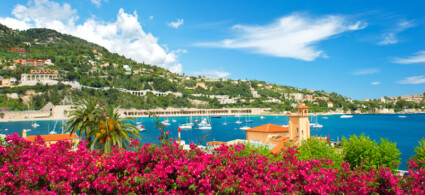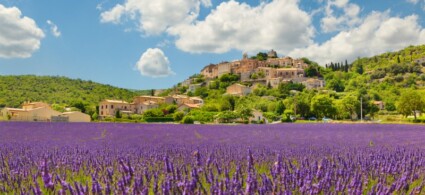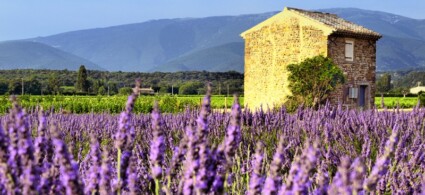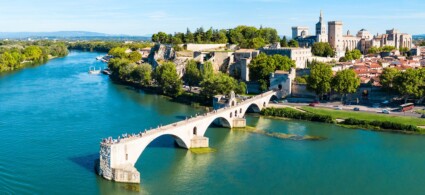

Provence is a beautiful region in the south of France, nestled between the Italian border to the east and the left bank of the Rhône River to the west. Beloved the world over for its picture-postcard views, Provence encompasses an incredible variety of landscapes: from the lavender fields that fade into the horizon to the red rock canyons of the Luberon, from the turquoise lakes and emerald rivers of the Verdon gorges to the calanques of Marseille, where you can dive into a crystal-clear sea, from the pinkish salt marshes of the Camargue to the Mediterranean maquis of the French Riviera.
These fairytale panoramas are interspersed with a series of villages perched on hillsides and beautiful towns, rich in art, history and archaeology. A riot of cobbled streets, shady squares under the foliage of plane trees, colourful flowers in the windows, bubbling fountains awaits you. From Arles to Aix en Provence, from Gordes to Avignon, from Nice to Antibes, Provence is a region waiting to be discovered and visited.
What makes your trip even more special is the colourful and folkloristic Provençal atmosphere, typical of the inland towns, complemented by the liveliness of the fashionable evenings on the coast. Not to mention the exquisitely Mediterranean cuisine, the harbours teeming with life, the crystal-clear sea and some of the most fascinating driving routes in Europe.

Avignon‘s brightest jewel is undoubtedly the Palais des Papes: this extraordinary building, declared a UNESCO World Heritage Site, was built in the early 14th century when the Catholic Church moved the papal court from Rome to Avignon. It is the largest Gothic palace in Europe.
Surrounding it is the beautiful old town of Avignon, overlooking the river, made up of picturesque medieval streets. In July, the Festival d’Avignon, a festival of theatre, dance and music that attracts spectators from all over Europe, takes place here.

Along the placid delta of the Rhône River, Arles preserves some of the most important vestiges of Roman Provence, recounting the events of a glorious past: don’t miss the Roman Theatre and the Arena, very similar to the Coliseum in Rome, which witnessed the games and gladiator fights for more than 400 years.
The lively life of Arles, deeply intertwined with gypsy culture, also enchants tourists from all over Europe: its enchanting historic centre was dear to Vincent Van Gogh, who lived the last years of his life here and found inspiration in the city’s many picturesque views.

Often called the Naples of France, Marseille is a city with a multi-ethnic vocation: in its maze of picturesque alleyways, people from all over the world coexist, creating a unique atmosphere.
In fact, Marseille is an authentic Mediterranean port city, characterised by a lively harbour, a cosmopolitan ambience, a cross-section of life: it used to be a dangerous and critical city, but in recent years it has been able to start a process of redevelopment to open up to tourism.
Today, it is no longer inadvisable to stroll through the historical quarter of Le Panier to find traditional Arab souks and taste traditional Algerian dishes. Don’t miss a stop at a waterfront restaurant in the Vieux Port (Old Port) to taste the Marseille speciality of bouillabaisse, an exquisite fish stew.

Aix-en-Provence has all the elegance of Paris combined with the warmth of the south of France. This traditional Provençal city is distinguished by its tree-lined boulevards, shady squares and ornate fountains.
Along the streets of the old town you can breathe in the liveliness of its markets and its deep connection with art: this town inspired great painters such as Cézanne, who chose to live here and immortalise Provençal landscapes such as Mont Sainte-Victoire, behind Aix-en-Provence.

Renowned for its Roman ruins, Orange is located in the Haut-Vaucluse region of Provence, an area that flourished during classical antiquity.
The Ancient Theatre from the 1st century AD bears witness to this ancient heritage. Declared a UNESCO site, it is one of the best-preserved theatres in Europe and still has intact decorations. During Roman times, crowds of more than 7,000 spectators flocked to the theatre to watch comedies, tragedies, dance performances, acrobatics and juggling.
Also not to be missed are the other sites in the archaeological area: the Arch of Triumph, dedicated to the emperor of ancient Rome Tiberius, and the Hemicycle, the ruins of a Roman temple adjacent to the theatre.

Perched on a rocky plateau overlooking a tranquil valley, Les Baux-de-Provence is located in the heart of the Alpilles and offers the best views of Mont Ventoux, the Luberon in the Haut-Vaucluse, the Rhone Valley, Aix-en-Provence and Arles.
Listed as one of the most beautiful villages in France, Les Baux-de-Provence stands out for its delightful old stone buildings, shady squares and terraces full of fragrant flowers. Wandering the old cobblestone streets, you will find charming cafés, small boutiques and inviting art galleries.
Don’t miss the ruins of the Château des Baux and its citadel, which seem to be part of the steep limestone cliff. By parking in the lower part of the village, you can climb up to the historic village: a leap back in time to the Middle Ages, to get to know and imagine the troubadour culture of chivalry and love poetry that flourished in this area in the 12th and 13th centuries.

The Abbey of Sénanque, five kilometres away from Gordes, is nestled in a valley covered with lavender fields: here you can capture one of Provence’s most famous views. This 12th century Romanesque building is considered one of the most interesting abbeys in France. Its harmonious architecture reflects the Cistercian concepts of isolation, simplicity and spirituality.
We recommend that you explore the valley surrounding the abbey, to hunt for photogenic spots: between July and August, the fields light up with the colours of lavender, a riot of unparalleled beauty. Our advice is to follow the lavender road, a route that will take you to the most beautiful parts of Provence and its picturesque villages.

The Valensole plateau is the quintessence of Provence: in July the expanses of lavender fields are in bloom and if you drive around you can stop and take wonderful photographs. In fact, it is in this area that you will find the greatest concentration of lavender fields, winding as far as the eye can see, offering breathtaking views, especially in the warm light of sunset.
Lavender farms and distilleries are scattered all over the Valensole region. Many lavender products such as essential oils, perfumed waters, soaps and even ice cream are sold here. One of our favourite fields is located along the Route d’Oraison, but you can find plenty of them in the villages of Riez, Valensole and Forcalquier.

The quaint perched village of Gordes is beautifully situated in the UNESCO World Heritage Luberon Regional Natural Park, a mountainous, wild and rugged area.
Thanks to its scenic hilltop location and beautiful architecture, Gordes has been named one of the Plus Beaux Villages de France and many artists, including Victor Vasarély and Marc Chagall, have found inspiration for their paintings here.
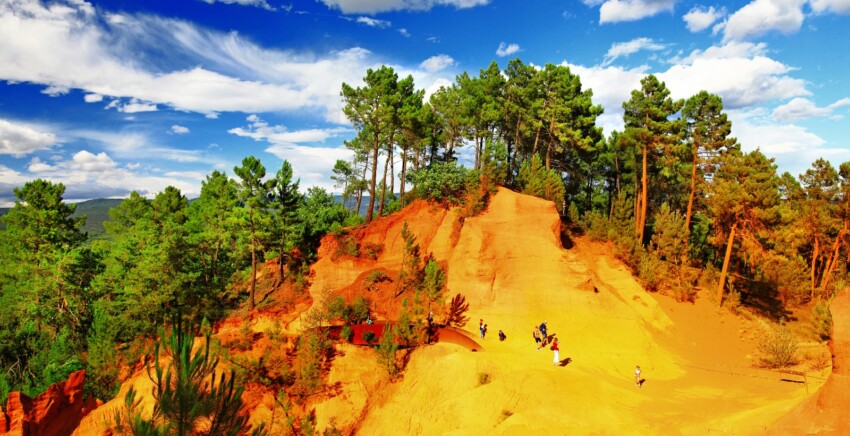
The charming village of Roussillon is famous for its unique colour palette, which derives from the soil on which it is built. Ochre deposits in the earth make this area of the Luberon glow an intense amber colour. The village houses are clad in a traditional ochre plaster, which provides resistance to the scorching sun and creates a vibrant contrast to the deep green vegetation surrounding the village.
This is the starting point of the famous Ochre Trail, a footpath that winds its way through the coloured cliffs inside a former ochre mine: here the colours are absolutely outstanding and the canyon offers glimpses of incredible beauty, in all shades of yellow, orange and red.
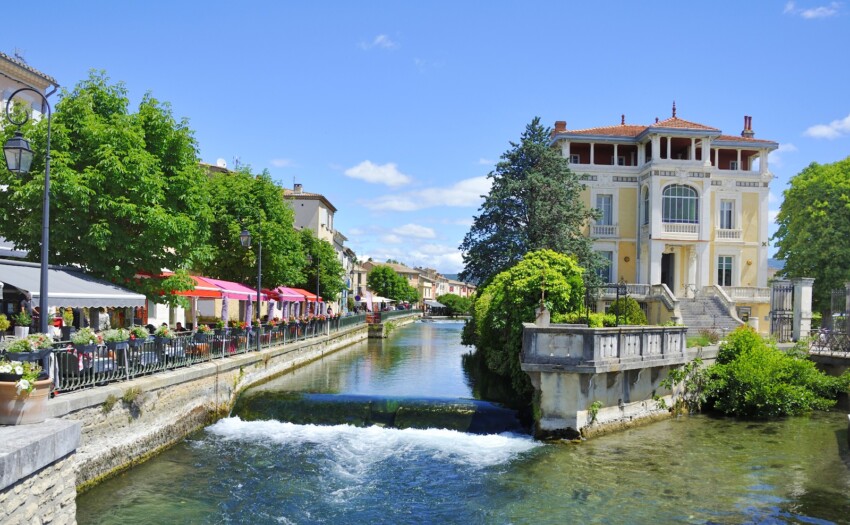
Isle-sur-La Sorgue is a small village with an exquisitely Provençal atmosphere: built on canals, interspersed with ancient water mills covered in verdant creepers, the village is one of the most beautiful postcards of Provence.
Don’t miss the floating market: every year, on the first Sunday in August, local producers, dressed in their best traditional clothes, glide on flat boats from one bank to the other at the call of the public. They sell the best of Provençal colours and scents: fruit and vegetables, bouquets of flowers, cheeses, wine, bread and olives.

You can’t plan a tour of Provence without spending some time in the spectacular landscape of the Camargue, a world apart in the Provence region: you’ll be left speechless by the marshy landscapes, the fishing villages, the lagoons where groups of pink flamingos stop and the large fields where white horses and bulls, the main symbols of the region, run.
Also not to be missed is a visit to Saintes-Maries-de-la-Mer, the most important town in the area, a mecca for gypsy pilgrims and a charming village where non-bloody bullfights and Camargue-style horse races take place.

For lovers of trekking, water sports and winding scenic roads, the tour of the Verdon gorges, an impressive canyon at the bottom of which winds the emerald green course of the Verdon river, is a must.
Breathtaking panoramas await you and the possibility of penetrating its most hidden corners by canoe or on foot.

The dreamy medieval village of Saint Paul de Vence is perched on a hill and surrounded by a ring of perfectly preserved ramparts. A must-see destination in Provence, Saint-Paul de Vence is often crowded with tourists, who take a diversion from the nearby attractions of the French Riviera.
In fact, the village is less than 20 kilometres from the most famous French Riviera seaside resorts, such as Nice and Antibes. In spite of these worldly towns, time seems to stand still in Saint-Paul de Vence. Entering through the ancient city gates, you will be transported to a magical place, consisting of labyrinthine cobbled streets, small alleys, flights of steps and tiny squares adorned with bubbling fountains.

The stretch of coast between the Italian border and Marseille is known by everyone as the French Riviera: a magnificent coastline known the world over for its charm and beauty. From the beaches and boardwalks of Cannes and Monaco to the lavender fields of Grasse and the medieval villages of Èze, there is a whole host of places to explore, especially in summer.
Let’s not forget a few towns full of social life and character such as Menton, with over 316 days of sunshine a year, exceptional gardens and quality French-Italian cuisine; Antibes with its picturesque old town, Cours Masséna, Provençal food market and Picasso Museum; and Saint Tropez, with its pastel colours and countless bars overlooking the harbour teeming with yachts.
In the following map you can see the location of the main places of interest mentioned in this article.
